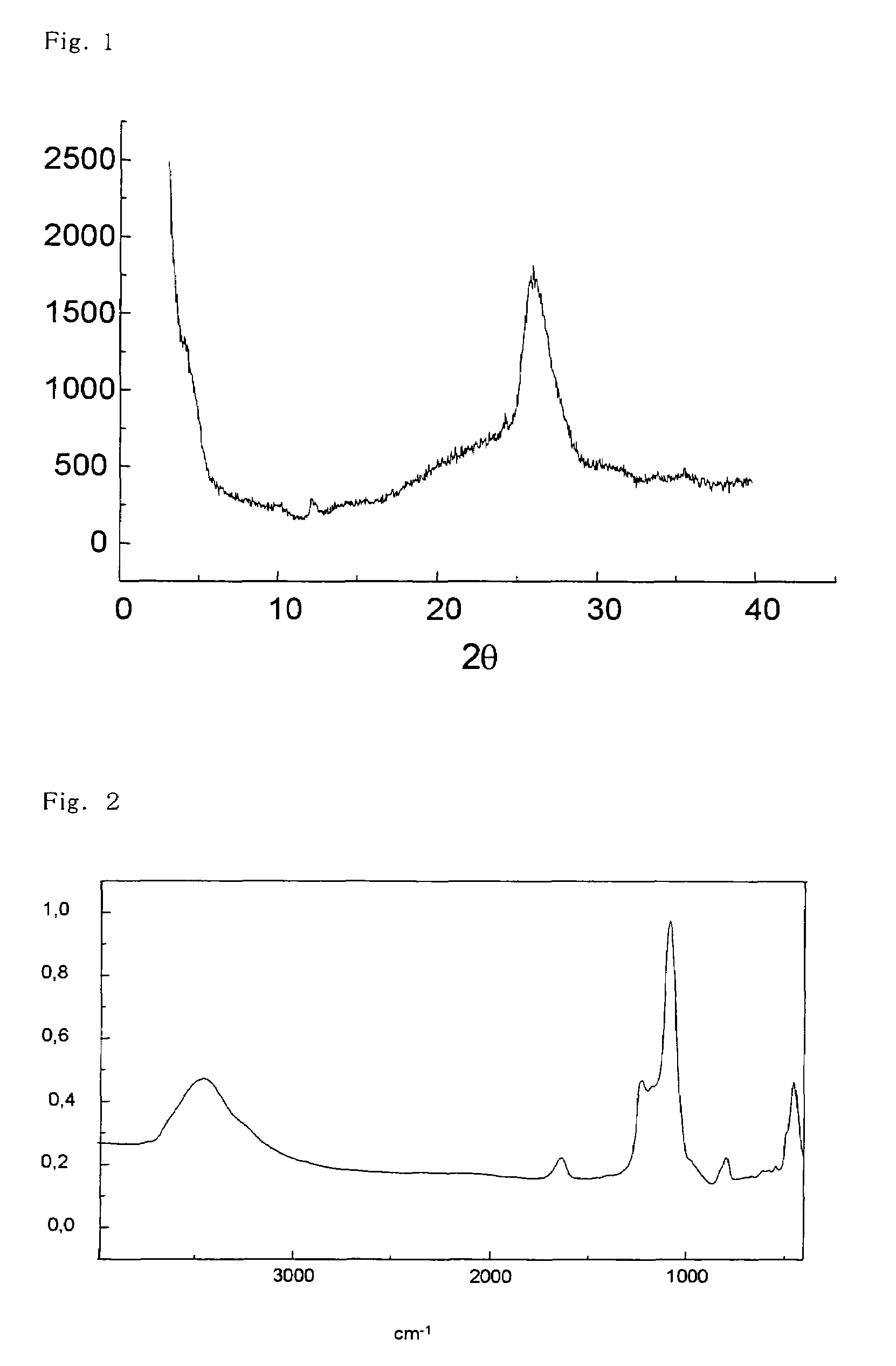Method for manufacturing cycloalkanol and/or cycloalkanone
a technology of cycloalkanol and cycloalkanone, which is applied in the direction of physical/chemical process catalysts, metal/metal-oxide/metal-hydroxide catalysts, foundation moulding apparatus, etc., can solve the problems of unsatisfactory catalyst activity and selectivity points, and achieve favorable degree of conversion and favorable selectivity coefficient
- Summary
- Abstract
- Description
- Claims
- Application Information
AI Technical Summary
Benefits of technology
Problems solved by technology
Method used
Image
Examples
reference example 1
Preparation of a Cobalt-supporting Kenyaite Having Pillars Formed at its Interlayer
(A) Preparation of a Cobalt-supporting Kenyaite
[0026]To an aqueous solution of sodium hydroxide (0.13 g) in water (1.9 g) in a beaker, tyramine (1.17 g) and colloidal silica (LUDOX AS-40 manufactured by Aldrich, i.e., an aqueous suspension of 40 wt. % of silica) (2.5 g) were added, and the mixture was stirred. Then, an aqueous solution of cobalt (II) acetate tetrahydrate (0.14 g) in water (1.0 g) was added, and the mixture was stirred for 4 hours. This mixture was set in an autoclave and stirred at 150° C. for 10 days. After that, the mixture was filtered, and the resulting solid residue was washed with water and dried in an oven at 100° C. for a whole day and night. Thus, a cobalt-supporting kenyaite (1.1 g) was obtained.
(B) Formation of Pillars at the Interlayer of the Cobalt-supporting Kenyaite
[0027]The cobalt-supporting kenyaite (1.0 g) obtained in the above preparation (A), water (4.1 g), an aqu...
reference example 2
Preparation of a Hydrotalcite-like Compound Which Supports a Salt of Heteropoly Acid
(a) Preparation of a Salt of Heteropoly Acid
[0028]Sodium tungstate dihydrate (19.8 g, 0.06 mol) and water (40 g) were charged in a 500 ml round bottom flask, and stirred at room temperature to form an aqueous solution. To this aqueous solution, acetic acid (4.1 g) was added to adjust the pH thereof to 7. Then, the solution was heated under refluxing. To this solution, an aqueous solution of cobalt (II) acetate tetrahydrate (2.5 g) in water (13 g) was added dropwise over 20 minutes, and the mixture was further heated under refluxing for 15 minutes. The mixture was cooled to a room temperature, and the solid precipitate was filtered off. Then, the resulting filtrate was heated under refluxing. To this filtrate, an aqueous solution of potassium chloride (13 g) in water (25 g) was added, and the mixture was further heated under refluxing for 15 minutes. The resulting mixture was cooled to a room temperat...
example 1
[0032]34 g (0.40 mol) of cyclohexane and 0.2 g of the above-mentioned cobalt-supporting kenyaite were put in a 50-ml autoclave, and the inside of the system was pressurized up to 0.5 MPa with oxygen at room temperature and thereafter heated up to a temperature of 130° C. and reacted under the flow of oxygen for 24 hours.
[0033]At a point in time of 5.5 hours after the start of the reaction, degree of conversion of cyclohexane was 3.5%, selectivity coefficient of cyclohexanone was 44.3%, selectivity coefficient of cyclohexanol was 52.1% and selectivity coefficient of cyclohexyl hydroperoxide was 0.1%. At a point (the end) in time of 24 hours after the start of the reaction, degree of conversion of cyclohexane was 5.4%, selectivity coefficient of cyclohexanone was 63.7%, selectivity coefficient of cyclohexanol was 24.3% and selectivity coefficient of cyclohexyl hydroperoxide was 0.2%.
PUM
| Property | Measurement | Unit |
|---|---|---|
| pressure | aaaaa | aaaaa |
| pressure | aaaaa | aaaaa |
| temperature | aaaaa | aaaaa |
Abstract
Description
Claims
Application Information
 Login to View More
Login to View More - R&D
- Intellectual Property
- Life Sciences
- Materials
- Tech Scout
- Unparalleled Data Quality
- Higher Quality Content
- 60% Fewer Hallucinations
Browse by: Latest US Patents, China's latest patents, Technical Efficacy Thesaurus, Application Domain, Technology Topic, Popular Technical Reports.
© 2025 PatSnap. All rights reserved.Legal|Privacy policy|Modern Slavery Act Transparency Statement|Sitemap|About US| Contact US: help@patsnap.com

